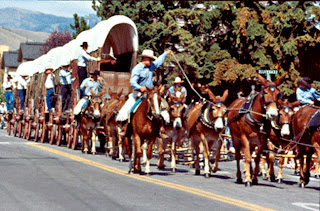 |
| H. C. Lewis. J. H. Hawley photo. |
A year later, in 1880, his father moved to Ketchum, Idaho to open a store. Horace soon followed, and he and a partner opened a lumber business near the town.
As the Wood River mines boomed, Lewis dealt in mining supplies as well as lumber for a time before operating a small freight outfit. Then, in 1884, the Oregon Short Line railroad extended its tracks into Ketchum, and Horace sensed a major opportunity. He founded the Ketchum Fast Freight Line, which made regular runs to mining camps in Bayhorse, Bonanza, Challis, Clayton, and Custer.
His Line also ran scheduled stagecoaches, but the “crown jewels” of his haulers were the huge freight wagons assembled by his own construction crews. Sixteen feet long, with seven-foot wheels at the back, the wagon box had about the same volume as a standard modern dump truck.* They could handle loads up to nine or ten tons. (The famed Conestoga wagon topped out at six tons.) They carried all kinds of goods – massive machinery, petticoats, whiskey, and more – into the mountains and brought out ore and bullion.
This was quite a feat, considering the state of the “roads.” Some parts of these tracks were little more than two ruts among the rocks and sagebrush, many stretches were barely wide enough for the wagons, and they encountered several acute grades. With five or six big wagons hitched together behind a “jerkline” of perhaps twenty mules, tight curves could be a harrowing challenge.
Even so, reports indicate that the Line had one season where it shipped seven hundred thousand pounds of bullion out to be loaded onto OSL cars. Over time, Lewis also invested in mining properties himself, and founded the First National Bank of Ketchum.
The freight and stagecoach business went into a lull after about 1895, but Lewis revived it during the Thunder Mountain rush of 1900-1907. Thunder Mountain is buried deep in the incredibly rugged Salmon River wilderness, over forty miles east of McCall. The mines never really showed much profit, but Lewis did all right hauling freight and passengers.
Later he took up ranching near Ketchum while continuing his business interests in town and around the region. As the mountain mines played out, there was less and less freight to be hauled. The lumbering trains of giant wagons were discontinued in 1909, two years before Lewis died.
 |
| Big Hitch ore wagons. Tourism photo. |
Thus, in 1958, boosters initiated “Wagon Days” in the Ketchum-Sun Valley area. Each Labor Day, the region’s frontier heritage is celebrated with concerts, antique shows, re-enactments, a carnival, readings of cowboy poetry, and other special events.
The highlight of the weekend is the Big Hitch Parade, and the highlight of the parade is the Lewis Ore Wagons: Six giant, century-old vehicles hitched in tandem behind a 20-mule jerkline … 200 feet of authentic Idaho history rumbling through the streets.
* Thanks to Hansen Wheel & Wagon Shop, which has restored several Lewis freight wagons, for the dimensions. Of course, being hand-built, the boxes vary somewhat in size.
| References: [Hawley] |
| Ketchum History and Information, City of Ketchum. |
| David Sneed, “Idaho Freight Wagons,” Wheels that Won the West Publishing, Flippin, Arizona (2005-2010). |
| Sun Valley-Ketchum Tourism. |

Evan, did Hoarce ever haul ore to Kelton? I have ruts on the Kelton route cut into the lava rock with a 5 ft. wheel base and also with a
ReplyDelete6 ft. wheel base. I'm not sure but possibliy the stage lines had a 5 ft. and the freighters had a 6 ft? Keep up the good work. Regards Paul
Paul,
ReplyDeleteI have researched the question of whether the big Lewis wagons were used to haul ore to the railroad at Kelton. But I have not found any evidence one way or another.
We do know that ore was hauled from the Wood River mines to the railroad at Kelton for processing in Salt Lake, or even Denver, so it's certainly possible. The question then becomes: Could any ferry on the route transport a Lewis wagon across the Snake? At best, I'd think they would have to break up the train and take the wagons across one at a time.